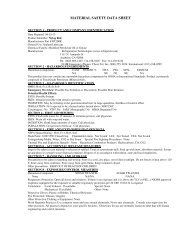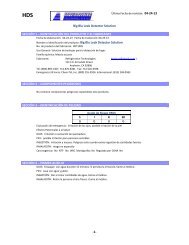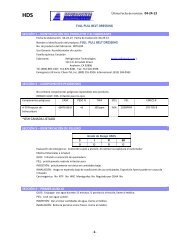Balancing of a Water and Air System (PDF
Balancing of a Water and Air System (PDF
Balancing of a Water and Air System (PDF
Create successful ePaper yourself
Turn your PDF publications into a flip-book with our unique Google optimized e-Paper software.
69<br />
4. Identify the riser with the highest flow ratio. Begin balancing with this riser, then<br />
continue to the next highest flow ratio, <strong>and</strong> so on. When selecting the branch with the<br />
highest flow ratio,<br />
Measure flow in all branches <strong>of</strong> the selected riser.<br />
In branches with flow higher than 150% <strong>of</strong> design, close the balancing valves to reduce<br />
flow to about 110% <strong>of</strong> design.<br />
Readjust total pump flow using the main valve.<br />
Start balancing in branches with a flow ratio greater than or equal to 1. Start with the<br />
branch with the highest flow ratio.<br />
The reference circuit has the lowest quotient <strong>and</strong> the greatest pressure loss. Adjust all<br />
other balancing valves in that branch until they have the same quotient as the reference<br />
circuit (at least one valve in the branch should be fully open).<br />
When a second valve is adjusted, the flow quotient in the reference valve will also<br />
change; continued adjustment is required to make their flow quotients equal. Once they<br />
are equal, they will remain equal or in proportional balance to each other while other<br />
valves in the branch are adjusted or until there is a change in pressure or flow.<br />
When all balancing valves are adjusted to their branches’ respective flow quotients, total<br />
system water flow is adjusted to the design by setting the balancing valve at the pump<br />
discharge to a flow quotient <strong>of</strong> 1.<br />
Pressure drop across the balancing valve at pump discharge is produced by the pump<br />
that is not required to provide design flow. This excess pressure can be removed by<br />
trimming the pump impeller or reducing pump speed. The pump discharge-balancing<br />
valve must then be reopened fully to provide the design flow.<br />
As in variable-speed pumping, diversity <strong>and</strong> flow changes are well accommodated by a<br />
system that has been proportionately balanced. Because the balancing valves have been<br />
balanced to each other at a particular flow (design), any changes in flow are<br />
proportionately distributed.<br />
<strong>Balancing</strong> the waterside in a system that uses diversity must be done at full flow.<br />
Because the components are selected based on heat transfer at full flow, they must be<br />
balanced to this point. To accomplish full-flow proportional balance, shut <strong>of</strong>f part <strong>of</strong> the<br />
system while balancing the remaining sections. When a section has been balanced, shut<br />
it <strong>of</strong>f <strong>and</strong> open the section that was open originally to complete full balance <strong>of</strong> the<br />
system. When balancing, care should be taken if the building is occupied or if load is<br />
69















